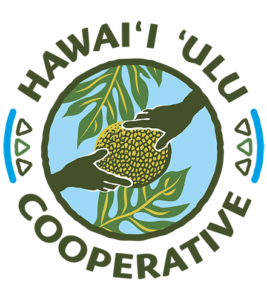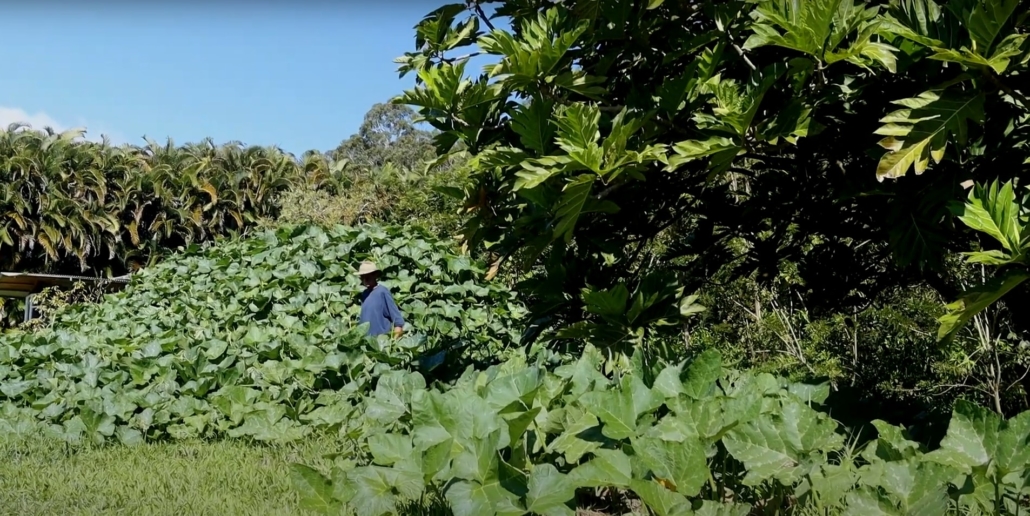Frequently Asked Questions
Potential Members/Co-op Curious FAQ
How do I apply for co-op membership?
To join the co-op, click here and follow the 5-step process to become a member!
What services does HUC provide?
- HUC provides an annual on-farm visit with our Farmer-Member Coordinator, which includes complimentary soil and ‘ulu tissue nutrient testing.
- Stable price and guaranteed market for their fruit
- Streamlined access to discounted fertilizers delivered right to your farm
- Technical assistance, on-farm workshops and ongoing training in sustainable production practices
- Regional connections with other HUC farmers, contractors, and events.
Is there a tree/fruit limit?
There is no limit on the number of trees or the amount of fruit you can deliver to the co-op. Active members with trees that are producing fruit are expected to deliver a minimum of 25 lbs a season to the co-op in order to remain a member in good standing.
Can I join the co-op if my ‘Ulu trees aren’t fruiting, or if I haven’t planted any ‘ulu trees yet?
Yes, as long as you successfully plant a minimum of one ‘ulu tree within one year of joining the co-op – you can be a member! However, remember that once your trees start to produce fruit, you are required to deliver a minimum of 25 lbs per season to the co-op to maintain your active membership status.
What if I am interested in joining the co-op and growing ‘ulu, but I don’t know where to start?
HUC is here to help! Our team has put together a series of videos and production guides to help you grow your own ‘ulu. We also have information on how to grow a variety of companion crops like pala’ai (squash) as well! Scroll down to the Producer Resources section below to find more information about producing ‘Ulu.
Do I have to be certified organic to join the co-op?
While HUC encourages sustainable and regenerative techniques on our member farms, there is no requirement to be fully organic or certified as such to join the co-op.
Can I sell fruit to the co-op if I am not a member?
You may sell fruit (‘ulu, kalo, pala’ai, ‘uala) to HUC as a non-member supplier; however some products have a lower pay price for non-members and only active members receive technical support.
Active Member FAQ
Where can I find info on growing ’ulu and co-crops like pala’ai (squash) kalo (taro), and more?
Check out our videos and production guides to help you grow your own ‘ulu at home or on your farm! Our ʻUlu Agroforestry in Hawaiʻi Guide is another great resource for learning how to grow ‘ulu in a diversified agroforest system.
We also have information on how to grow a variety of companion crops like pala’ai (squash) as well! Grower’s guides for ‘uala (sweet potatoes), kalo (taro), and cassava (tapioca) are in the works and will be released throughout the summer of 2022!
Where can I purchase ‘Ulu trees?
HUC currently has a waitlist for our varieties of ‘ulu saplings; you can place your order here to get on the waitlist today. Our Member Resource Directory also contains a list of nurseries across the islands that carry ‘ulu!
Where can I purchase and learn more about fertilizers?
Nutrient management is vital to maximize your fruit quality and yield. Check out Dr. Noa Lincoln’s Breadfruit Nutrient Management Guide on HUC’s website to learn more, watch our video on ‘Ulu nutrient management, and use our handy fertilizer calculator to estimate your particular fertilizer needs.
We’ve also partnered with Nutrien to offer co-op members special pricing on recommended fertilizer blends for ʻulu; give them a call and pick up at their Hilo location at 888 Kalanianaole St: (808) 935-7191. Let them know you are an HUC member and ask for our bulk member discount!
How Do I Schedule a Farm Visit
- Schedule your visit here
General Producer FAQ
Where and at what elevations does ’ulu grow best? Is there a best variety for higher elevations?
‘Ulu grows best in tropical lowlands up to 1500 ft in elevation; ‘ulu can grow higher than this but is not viable for commercial production. The trees prefer fertile, well drained soils with ample potassium (K). Trees grown above the recommended elevation often produce very small fruits, if any at all.
Currently there is no established variety which does better at higher or lower elevations, growers in higher altitudes are encouraged to consider planting varieties other than ma’afala as this variety can produce fruits on the smaller side.
How do I know when my ‘ulu is ripe and ready for harvest?
Check out our ‘Ulu Maturity Stages video for a detailed example of different stages of maturation during breadfruit season! Also, look at our updates FY 23’ Harvesting Guide and Best Harvest Practices.
What is the best variety?
Everyone has their own preferences, but the traits and qualities of various ‘ulu varieties are explored here; currently, the co-op is selling Hawaiian, Ma’opo, and Otea varieties. Growing multiple varieties can provide staggered harvest times and more resilience to pests and diseases, but it’s okay to plant based on preference or availability!
Are ma‘afalas all considered B grade because they are smaller?
No not all ma‘afala fruit that we receive is rated as B-grade – we have several farmers with 100% A grade deliveries. Remember that A grade fruit needs to be 5 inches horizontally or vertically to fulfill this threshold.
Suggestion box
Donʻt see your question answered here or want to make a suggestion to the co-op? Fill out the simple form below and we will do our best to respond!


